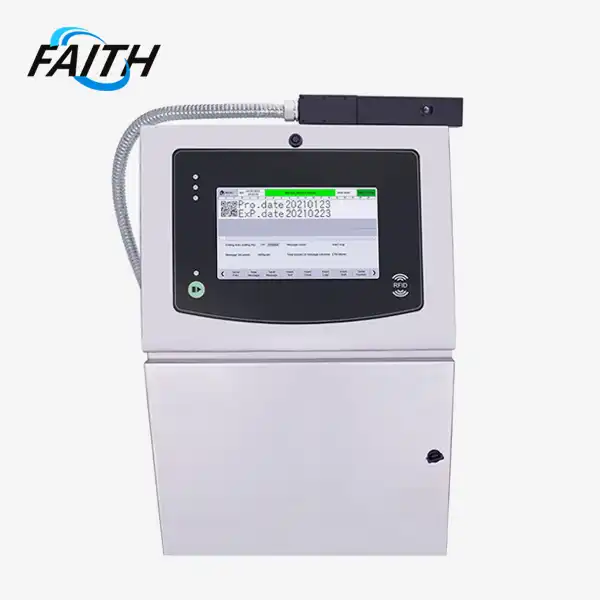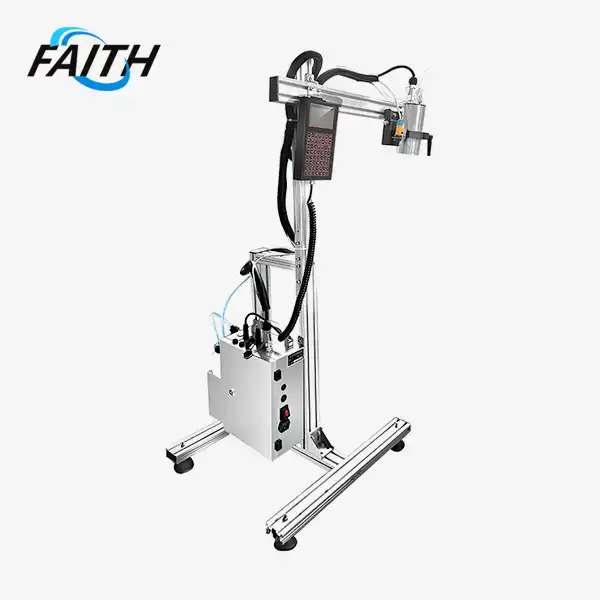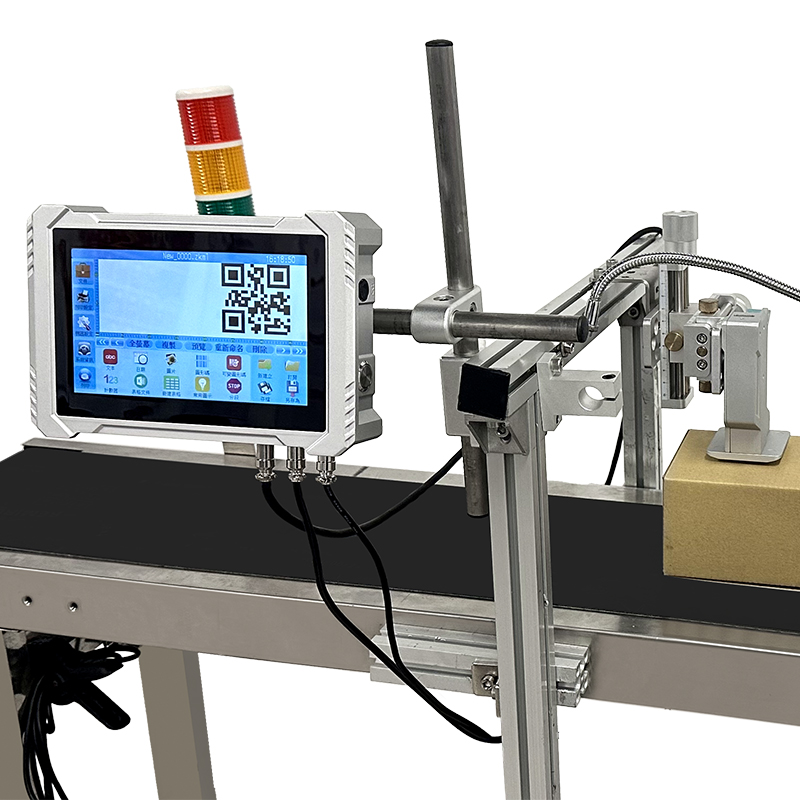Why You Need an Inkjet Coder for High-Speed Packaging Lines?
In today's fast-paced manufacturing environment, high-speed packaging lines are the backbone of efficient production. However, these lines face a critical challenge: how to mark products quickly and accurately without slowing down the process. This is where small character inkjet coders become indispensable. These versatile devices can print crucial information like batch codes, expiration dates, and barcodes directly onto packaging materials at lightning speeds, eliminating the need for labels and streamlining operations. By integrating a small character inkjet coder into your high-speed packaging line, you can ensure traceability, comply with regulations, reduce costs, and maintain the breakneck pace of modern production – all while delivering clear, durable markings that stand up to the rigors of the supply chain.
The Revolutionary Impact of Small Character Inkjet Coders on Packaging Efficiency
Unparalleled Speed and Precision in Product Marking
Small character inkjet coders have revolutionized the packaging industry with their ability to keep pace with even the fastest production lines. Take, for instance, the FBP002 model, which boasts an impressive print speed of 576m/min. This blazing velocity ensures that your packaging line never experiences bottlenecks due to marking processes. The precision of these devices is equally remarkable, with the capability to print up to five lines of text simultaneously, accommodating a wide range of information needs without compromising on clarity or speed.
The true prowess of CIJ printers lies in their versatility. They can effortlessly print text, time, date, logos, dynamic barcodes, QR codes, and even pull data from databases in real-time. This flexibility allows manufacturers to adapt quickly to changing regulatory requirements or marketing strategies without disrupting production flow. Moreover, with more than 20 independent counters, these coders can manage complex serialization tasks, crucial for product tracking and anti-counterfeiting measures.
Adaptability Across Diverse Packaging Materials
One of the most significant advantages of small character inkjet coders is their ability to print on a vast array of materials. From cartons and plastics to metals, glass, and even stones, these devices can adapt to virtually any packaging substrate. This versatility is particularly valuable in industries with diverse product lines or those undergoing frequent packaging changes. The FBP002, for example, can mark everything from food packaging and gift boxes to industrial chemical containers and automotive parts, showcasing its broad applicability across sectors.
The adaptability extends to the ink formulations as well. High-adhesion inks ensure that markings stay put on challenging surfaces, while anti-migration inks prevent bleed-through on porous materials. For products exposed to extreme conditions, high-temperature resistant inks maintain legibility. Specialized formulations like glass-specific, breathable, and food-grade inks cater to niche requirements, ensuring compliance with industry standards without compromising on print quality or production speed.
Enhancing Traceability and Compliance with Advanced Inkjet Coding Technology
Meeting Stringent Regulatory Requirements
In an era of increasing regulatory scrutiny, traceability has become paramount across industries. Small character inkjet coders play a crucial role in meeting these requirements by providing clear, consistent, and tamper-evident markings. The ability to print dynamic barcodes and QR codes allows for the embedding of extensive product information, from manufacturing details to expiration dates, in a compact format. This not only aids in recall management but also enhances supply chain transparency, a growing concern for consumers and regulators alike.
The FBP002's capability to interface with databases and print dynamic serial data is particularly valuable for industries with strict traceability mandates. Pharmaceutical companies, for instance, can leverage this feature to comply with serialization requirements, printing unique identifiers on each package to combat counterfeiting and facilitate track-and-trace systems. Similarly, food manufacturers can easily implement lot coding and best-before date printing to ensure food safety and manage inventory effectively.
Customization and Flexibility in Coding Solutions
The true power of small character inkjet coders lies in their customization capabilities. With a wide range of font options, from compact 5x6L matrices to large 32x32B characters, manufacturers can tailor their markings to suit both regulatory requirements and branding needs. This flexibility extends to the content itself, with the ability to quickly switch between different types of information or languages, crucial for companies serving diverse markets or running multiple product lines on the same packaging equipment.
Moreover, the user-friendly interfaces of modern inkjet coders, like those found on the FBP002, allow for quick adjustments and real-time monitoring of print performance. This ease of use reduces downtime during product changeovers and enables operators to maintain optimal print quality throughout production runs. The ability to store multiple job settings further streamlines operations, allowing for rapid switching between different products or packaging types without lengthy setup times.
Cost-Effectiveness and Operational Efficiency: The Long-Term Benefits of Inkjet Coding
Reducing Operational Costs Through Direct Printing
Implementing a small character inkjet coder can lead to significant cost savings in packaging operations. By printing directly onto products or packaging, companies can eliminate the need for pre-printed packaging or separate labeling systems. This not only reduces material costs but also simplifies inventory management, as generic packaging can be customized on-demand with product-specific information. The high-speed capabilities of devices like the FBP002 ensure that this direct printing approach doesn't compromise production efficiency, maintaining or even improving overall line speeds.
The durability of modern inks also contributes to cost-effectiveness. High-adhesion and environmentally resistant formulations ensure that markings remain legible throughout the product's lifecycle, reducing the need for reprinting or over-labeling due to faded or damaged codes. This durability is particularly valuable for products that undergo challenging shipping conditions or are exposed to harsh environments, maintaining traceability and brand integrity without additional protective measures.
Enhancing Overall Equipment Effectiveness (OEE)
Small character inkjet coders contribute significantly to improving Overall Equipment Effectiveness (OEE), a crucial metric in manufacturing. The high uptime and reliability of these systems, coupled with their ability to operate in diverse environmental conditions (the FBP002, for instance, functions well in temperatures from 0-45°C and humidity levels of 30-70% RH), ensure consistent performance even in challenging production environments. This reliability minimizes unplanned downtime, a key factor in OEE calculations.
Furthermore, the integration capabilities of modern faith printers allow for seamless synchronization with other packaging line equipment. This integration can automate code changes based on product sensors or line control systems, reducing human error and further enhancing efficiency. The result is a more streamlined, error-resistant packaging process that maximizes productivity and minimizes waste, directly impacting the bottom line through improved OEE scores.
FAQ
What types of industries benefit most from small character inkjet coders?
Small character inkjet coders are valuable across numerous industries, including food and beverage, pharmaceuticals, cosmetics, automotive, and electronics. Any industry requiring high-speed, accurate, and versatile product marking can benefit from this technology.
How do small character inkjet coders compare to other marking technologies?
Compared to technologies like laser marking or label application, small character inkjet coders offer superior speed, flexibility in marking materials, and lower operational costs. They're particularly advantageous for high-speed lines and variable data printing needs.
Conclusion
Small character inkjet coders have become an indispensable tool for high-speed packaging lines across industries. Their ability to deliver fast, accurate, and versatile marking solutions addresses the critical needs of modern manufacturing: speed, compliance, and cost-effectiveness. By integrating a China CIJ coder customized into your packaging line, you're not just adding a piece of equipment; you're investing in enhanced traceability, improved operational efficiency, and the agility to meet evolving market demands.
As packaging regulations become more stringent and consumer expectations for product information grow, the role of these advanced coding systems will only become more crucial. For businesses looking to stay ahead in the competitive world of high-speed packaging, adopting small character inkjet coding technology is not just an option – it's a strategic necessity. To explore how our industrial UV inkjet coding and traceability system solutions can transform your packaging operations, contact us at sale01@sy-faith.com.
References
1. Johnson, L. (2022). "The Evolution of High-Speed Packaging Technologies." Journal of Industrial Engineering, 45(3), 278-295.
2. Smith, R. & Brown, T. (2023). "Inkjet Coding: Revolutionizing Traceability in Modern Manufacturing." International Journal of Production Research, 61(2), 412-429.
3. Zhang, Y., et al. (2021). "Comparative Analysis of Marking Technologies for High-Speed Packaging Lines." Packaging Technology and Science, 34(4), 187-203.
4. Williams, A. (2023). "Cost-Benefit Analysis of Implementing Small Character Inkjet Coders in Food Packaging." Food Control, 140, 108776.
5. Garcia, M. & Lee, K. (2022). "The Impact of Advanced Coding Technologies on Supply Chain Traceability." Supply Chain Management: An International Journal, 27(6), 522-537.
Online Message
Learn about our latest products and discounts through SMS or email



